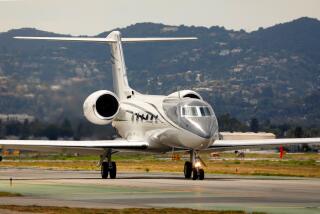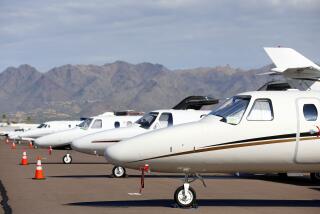Corporate jet expenses rise at big firms
- Share via
If you’re a business traveler who has been flying coach to save your company money, you may need to sit down to read the following news.
Chief executives of some of the nation’s biggest firms have increased spending about 9% on the personal use of corporate jets over the last year, according to a new study of corporate expenses.
The findings, published last week by the Corporate Library, an independent research firm, are based on data from nearly 340 major U.S. companies’ expense reports for personal jet use in the last two fiscal years.
In fiscal 2008-09, the average corporate jet expense was about $131,000, according to the study.
The biggest corporate jet expenses were filed by Gary Convis, the former CEO of Dana Holding Corp., an auto parts and systems supplier in Toledo, Ohio. Dana Holding paid nearly $1.2 million in aircraft bills for Convis and reimbursed him almost $25,000 for the personal taxes he paid, the study said.
A Dana Holding spokesman said the company paid only $165,000 in travel expenses for Convis in 2009. Convis stopped using the private jet in May and switched to commercial jets, according to the company’s proxy statement.
No. 5 on the study’s list of top spenders was Howard Lester, outgoing chairman and CEO of Williams-Sonoma Inc., the report said. It said the San Francisco-based retailer paid more than $675,000 in expenses for a jet leased from a company owned by Lester.
Representatives for Williams-Sonoma could not be reached for comment.
Michelle Lamb, who compiled the study, said the Corporate Library looks into such expenses to give investors an idea of the spending practices of companies’ leadership.
“We see these spending practices as a red flag,” she said. “We thought we would see more restraint.”
Conferences are staying frugal
While the economy shows signs of a rebound, meeting planners continue to watch their nickels and dimes.
That’s the conclusion from Benchmark Hospitality International, a Texas company that operates 30 hotels, resorts and conference centers worldwide.
After analyzing bookings and sales practices at its properties, the company came up with these business meeting trends for 2010:
* More planners are booking in the short term, unwilling to commit early.
* Meetings are smaller, in some cases including only half as many participants as in the past. They are also shorter, often by one day.
* Planners are cutting out spas and golf outings, focusing instead on the basics.
* Demand for lower prices and more concessions is increasing.
* Fancy meals are being replaced with buffets. “For the first time,” the report said, “buffets are seen as perfectly acceptable for all executives -- even those from Fortune 500 companies.”
Airlines trade jabs in their ads
The battle is on.
As part of its campaign to remind fliers that Southwest Airlines doesn’t charge for the first two checked bags, the low-cost carrier has been taking direct shots at its competitors, sparking a clash of advertising.
Southwest took a jab at AirTran Airways last month with a TV commercial called “Battle Cry.” In the ad, a group of Southwest employees stand on an airport tarmac and open their shirts to reveal “Bags fly free” spelled out on their chests while people on a competing airline’s plane look on.
The name of the competing airline is pixelated in the commercial but resembles that of AirTran, which charges $15 for the first checked bag and $25 for the second.
AirTran responded with an online ad called “Skip the Stampede,” which portrays passengers dressed as cows racing into a plane. The logo of the cattle-cramming airline is pixelated but looks like Southwest’s.
The AirTran video ends with the message: “Skip the stampede. AirTran Airways. Assigned seats, business class and Wi-Fi on every flight.”
Southwest will keep producing humorous ads and doesn’t plan to counterattack, spokeswoman Whitney Eichinger said.
More to Read
Inside the business of entertainment
The Wide Shot brings you news, analysis and insights on everything from streaming wars to production — and what it all means for the future.
You may occasionally receive promotional content from the Los Angeles Times.










